Legislative Plan Slices and Dices Upstate for Raw Partisan Advantage
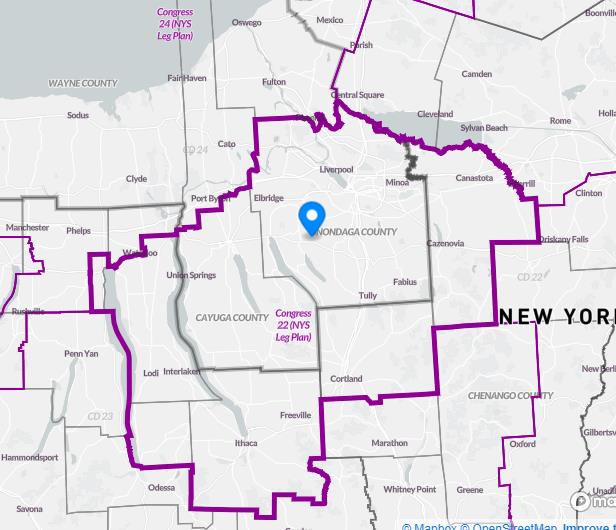
by Robert Lynch, January 31, 2022
Tompkins County is a “Blue County,” politically. Enfield is also a “Blue Town,” only a little more lavender than some of its neighbors in or near our County Seat. So for some of us, perhaps it’s time to step back, cease our salivating, and acknowledge a, true, raw, political fact. What the New York State Legislature handed up Sunday, January 30th as a Congressional Redistricting Plan for New York State is Gerrymandering pure and simple. It’s politics, and it ain’t pretty.
And we who are Democrats had better all pause for a Gut Check. Is it perfectly acceptable for we in control of New York’s—and Tompkins County’s; and Enfield’s—politics to sharpen our knives at the opportunity to seize a greater share of New York’s Congressional delegation with a “Turnabout is fair play” mentality; the reality that we Democrats are only flexing our partisan muscles in one direction to counter what Republican majorities elsewhere are doing in the other? Or should we stand on principle? Should we insist that we’re not going to play in the other party’s political gutter? Should we promise to be “Good Government Types” through and through? Should we walk away from temptation, listen to the Better Angels of modern-day Democracy, even at the price of losing control of the next Congress in the process?
Tough call, isn’t it?
So, here’s what the New York Legislative leaders have brought us. And leadership has signaled State Senators and Assemblymembers could cast votes on this plan as soon as this Wednesday, Ground Hog Day. Lopsided Democratic majorities control both legislative houses. In Albany, donkeys get what they ask for.
First, close to home: District lines not too bad; but imperfect. The newly-proposed 22nd Congressional District would be custom-made for any Democrat. And for those in our county’s majority party suffering under the perceived yoke of Tom Reid’s Republican domination, it would be a dream come true.
Similar to the now-scuttled Independent Redistricting Commission’s plans that came (and went) before it, the legislatively-drafted 22nd District would tie Tompkins County—all of Tompkins County—with Syracuse. It would put Tompkins as its southern anchor and Oneida Lake at its northeastern limit. The 22nd, effectively the “home” of retiring Congressman John Katko, would include all of Onondaga County, but no longer snake as far east as Utica, as some of the Independent Commission’s drafts had done. The district to represent Ithaca would also include both Geneva City and Town, as well as Auburn, Seneca Falls, and large swaths of both Cayuga and Seneca Counties. It would include Cortland and Homer, but not Cortland County’s more southerly towns of Virgil and Harford. In terms of the Finger Lakes, some might call it the “Wine Trail East District.”
A stock rule in gerrymandering is the principle of “stacking.” Try to crowd enough—but not too many—like-minded voters into a single district; enough to win your political party an election, yet not to waste too many of your party’s valuable voters that you could better employ elsewhere. In that regard, the new 22nd becomes a “stacked” district. Urban centers like Syracuse and reliably-Democratic liberal bastions like Ithaca are methodically roped in. Yet enough rural countryside is retained to keep Republican-leaning populations there in a decided (decade-long?) minority. The combination of lightly red and deeper blue keeps Democrats dominant, with Republicans left with little to do but complain.
But did the crafty line-drawing artists deliberately, or inadvertently, engineer this intriguing quirk? Generally, in their drafting, representational districts must be contiguous. They must remain connected. The proposed NY-22nd is not, unless, perchance, you own a boat.
Look to the northwest. Geneva Town and City are drawn into the district, but only by water. The district would reach as far north into Seneca County as the Seneca Canal, the northern boundary of the Fayette Town, yet no farther. But Waterloo, the town that links Fayette to Geneva along the northern shore of Seneca Lake, would be in another House District, NY-24th (more on that monstrosity later.) Unless one considers Seneca Lake State Park a “community” of its own (it isn’t), only lake water would bond one part of the district to the other. The boundless creativity of “Gerry Mander” can astound us all.
With Congressional District politics moving ever-so-quickly in the wake of Sunday’s map releases, Utica-based, Trump loyalist, Congresswoman Claudia Tenney, announced Monday (Jan. 31st) her plans to vacate much of her chopped-up Mohawk-to-Binghamton bastion, and instead attempt to succeed the retiring Tom Reed in the only-slightly reconfigured 23rd District; the one that stretches across the Southern Tier, swinging through Elmira and west to Jamestown.
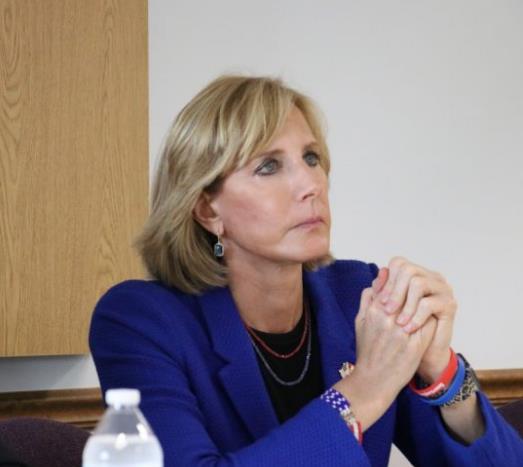
“Throughout my career I have stood up for Upstate New York and the Southern Tier, fighting for our shared conservative values in Albany and Washington,” Tenney wrote in a statement posted Monday to Twitter, picked up by media outlets.
According to one of those outlets, Radio Station WSKG, Tenney’s running in a district in which she does not live is perfectly legal, providing she still lives a in the state where she chooses to run. Nonetheless, in political circles, the less-than-admirable practice of seeking greener political pastures away from home bears the ignoble term of “mattress dragging.” (Chris Matthews once told me that.)
Several other Republicans have also announced plans to run as Reed’s potential successor. But with solid pro-Trump credentials and a mammoth war chest, Tenney enters the Republican contest as the undeniable rock star frontrunner; an incumbent ever-so-likely to draw the ex-president to visit the Southern Tier sometime before any June primary. One can only guess where the rally might be held. Maybe Elmira? An easy drive for the curious.
To the relief of local Democrats, the legislative plan would no longer place any of Tompkins County into the rebuilt NY-23rd. As currently proposed, the redrawn Reed (Tenney) district would reach only as close as Tioga and Schuyler Counties, including places like Candor, Spencer and Odessa. The current plan would tie the Schuyler County Town of Hector, Enfield’s western neighbor, into Tompkins County’s Syracuse-centered NY-22nd.
The New York Times reported Sunday that the Democratic legislative redistricting scheme could win three more House seats for the party of the donkey, despite the fact that New York’s shrinking population will actually forfeit a Congressional seat to other states that had population growth this census cycle. And as with the Southern Tier 23rd, the Democrats’ design would employ another gerrymandering principle, “packing” to cram as many rural conservatives into a single district, effectively, in a few places, forcing the GOP into wasting their party’s reliable votes in excess.
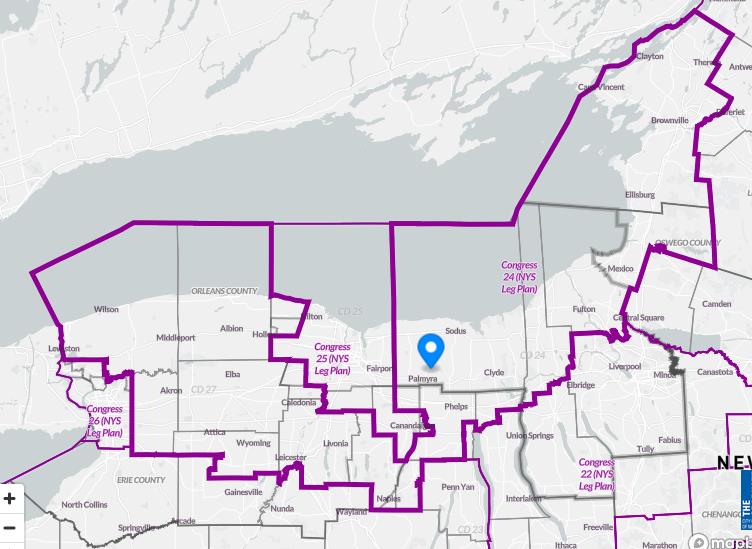
Look at the proposed 24th District. It’s a beauty. It would hug the Lake Ontario shoreline all the way from Alexandria Bay on the east to Youngstown on the west. On its journey, the rural-based district would consume all of Wayne County, northern Cayuga and Seneca Counties (including that Waterloo link between Fayette and Geneva) then go roundabout under (but not through) the Rochester metro and onward to western towns like Batavia, Livonia, and Lockport. It’s very long, very red, and—by the way—just barely connected.
Look at that narrow gap, a mere few miles wide, squeezing through southern Ontario and western Yates Counties near Rushville and Naples. With Canandaigua Lake as a natural barrier, the narrow gap barely connects east to west. And in so doing, it skirts Rochester and most of its suburbs and exurbs so that they remain a Democratic safe harbor.
At this writing New York’s legislative leaders had yet to release proposed State Senate and Assembly maps. It will be interesting when they do. And when they do, we’ll add those maps to this story.
New York’s Republican leadership has spared no fury in criticizing what the Democrats have wrought—and will likely adopt.
“These maps are the most brazen and outrageous attempt at rigging the election to keep Nancy Pelosi as speaker,” said Nick Langworthy, chairman of New York’s Republican Party, as quoted Sunday by the New York Times. Democrats, he said, “can’t win on the merits so they’re trying to win the election in a smoke-filled room rather than the ballot box.”
Langworthy described the map as “textbook filthy, partisan gerrymandering.” The leader recognizes Republicans lack the votes to stop the redistricting plans in the State Senate and the Assembly. But the Times said Langworthy hinted that Republicans could challenge the proposed reapportionment plan as unconstitutional in court.
****
Does Langworthy have a case here? Or is bare-knuckles politics the name of the game now? How would we who are Democrats view this were it happening in Georgia, Texas, Wisconsin or in our neighboring Pennsylvania? Are the goose and the gander fair equals here? And yes, do we delude ourselves for pretending to take a different road than the MAGA crowd ?
Stay tuned. And please, Democrats, try not to gloat.
###
Crafting the “Transformative” Camel
Lawmakers ponder how to dish-out the Community Recovery Fund
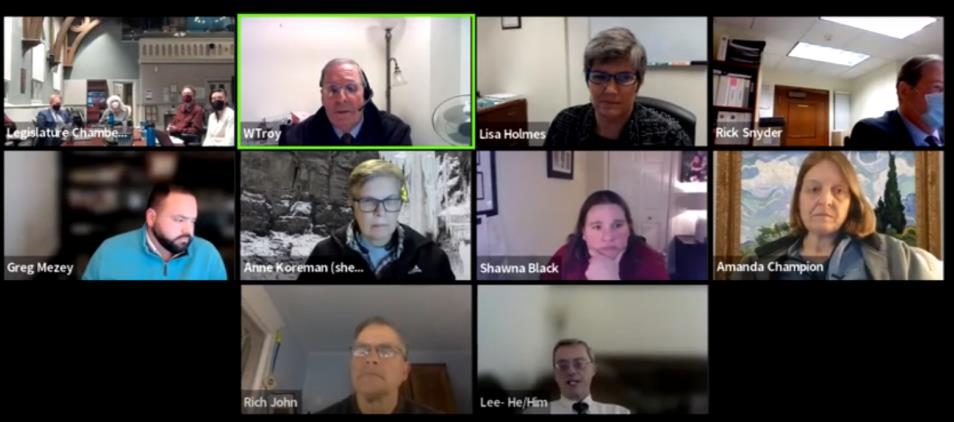
Posted by Robert Lynch, January 26, 2022
Warning #1: This was a meeting about process, not substance. So despite the fact it was January, legislators often wandered off the plowed paths and into the drift-covered weeds. Warning #2: The committee meeting Tompkins County lawmakers attended had, in truth, no binding authority. So nothing decided that evening may hold longer life than a melt-weather snowman until it’s affirmed by the full Legislature on some future date, if ever.
That said, the more than three-hour session of the Tompkins County Legislature’s Expanded Budget Committee Monday (Jan. 24th) provided the rest of us plenty of ad hoc insight as to how those we’ve elected to represent us downtown may parcel out $6.5 Million in local moneys budgeted to underwrite yet-to-be-sought human service projects under Tompkins County’s so-called “Community Recovery Fund.”
One of the oft-mentioned potential beneficiaries is the Enfield Food Pantry, whose leaders may apply for a Recovery Fund grant to underwrite, in whole or in part, the new distribution center they hope to construct.
The awards remain months away. The requests have yet to be tendered. A consultant has yet to be hired. And the consultant, itself, could cost taxpayers big bucks. Figures given the committee that night revealed consultants vying for the job may charge between $200,000 and $1.6 Million for their services.
“We’re going to end up with a camel and no horse,” legislature Budget Committee Chair Deborah Dawson warned as the marathon meeting had just warmed up. “But that’s okay,” she said, “as long as everybody is happy with some feature of the camel.” And true to Dawson’s prediction—and the first rule of construction by committee—the longer the meeting dragged on, the more the dromedary took shape. At a meeting supposedly called to help guide a someday-chosen consultant in its grant-application review, members made clear as the hours advanced that they, themselves, will micromanage the process.
The committee tentatively—remember, everything was truly tentative—rejected the option of having the consultant hand them only the projects it would recommend lawmakers support. Instead, legislators will likely look at both good ideas and bad. Legislators also split the Recovery Fund into three categories based on an applicant’s financial appetite.
The meeting’s consensus: On the low end, there’d be small grants, those from between $10,000 and $25,000; followed by mid-size appropriations, running up to $250,000; and then big-ticket awards costing upwards of a Quarter-Million. Each category would find a fraction of the Fund’s $6.5 Million total set aside for it, with a bit of flexibility built in. Up to One-Half Million Dollars would be earmarked exclusively for the smallest projects.
Somewhere; either at the Recovery Fund’s inception, or later along the way, those in charge had insisted all moneys spent become “transformative,” that is, that they accomplish some kind of community sea change, however one might define it. But the word “transformative” now finds its critics.
“Not everyone was dead set that these grants had to be transformational,” said legislator Amanda Champion Monday, speaking in defense of the smaller agency hand-outs. “What’s transformative varies from person to person; from organization to organization. So, I believe using that word is what some people (earlier) really felt was important, but not everyone agreed on.”

Last September, the County Legislature created the Community Recovery Fund by drawing cash out of the County’s bulging fund balance. Lawmakers sought to honor the spirit of the federally-gifted American Rescue Plan (ARPA), a nearly $20 Million Washington promise to Tompkins County to help it recover from the COVID-19 pandemic. But instead of spending the ARPA award on human service needs, the Legislature last summer plowed the federal millions into government operations, mostly capital construction. Initially $7 Million, the hometown ARPA substitute got whittled down by nearly $500,000 last fall as the legislators tacked this and that onto the current year’s overall Budget. Later this year, the Legislature, guided by its eventual consultant, will decide how to allocate what’s left.
Monday’s meeting became one of false starts, then backtracking. The committee constructed its bureaucratic camel much the same way it famously attempted to do so last August when it first conceived the Recovery Plan at a rambling bull session so unfocused that no reporter could ever have constructed a cogent story afterward. (I gave up.)
First, at Monday’s meeting, the committee set funding categories.
“I’d hate to see a community group that doesn’t have a lot of resources—I’d hate to see them cut out of the process,” said Danby legislator Dan Klein, arguing successfully for the lower-level set-aside, thereby ensuring that larger agencies with grander visions wouldn’t gobble up the cash.
But Ithaca’s Rich John, the lead advocate for “transformative” change, looked from the other direction, fearing that nickel-and-diming could squander opportunity.

If we “just pour the 6.5 Million into a ton of small projects,” warned John, “maybe that would be transformative to the community, but probably it wouldn’t do things in ten years we could say, ‘Yeah, that changed our community, our landscape in some significant way.’”
In setting aside a maximum of $500,000 for the smaller grants, lawmakers toyed with, then rejected, bypassing the consultant altogether for small-scale funding. “We need accountability and compliance,” reasoned Dryden’s Mike Lane. And “we don’t have the bandwidth,” he said, for County staff to handle the job themselves.
But as the meeting wore on, newly-named County Attorney Bill Troy confided he’d been “fidgeting;” growing increasingly nervous about what many view as the nemesis of modern mankind, the Grinch of Good Governmental Intentions—the trial lawyer:
“Some of these grants can be big dollars,” Troy warned legislators. The County Attorney said he could envision two nursing homes or a pair of cash-hungry real estate developers battling it out for a big chunk of the Recovery Fund’s pie, with the loser then demanding judge and jury settle the matter by parsing the meaning of the Legislature’s weakly-defined standard of “transformative.”
“How do we avoid the ‘L-Word,’ of lawsuit,” Troy asked. “It could be an absolutely frivolous lawsuit. But it’s a lawsuit…. Not everybody that’s going to come to you is going to have a good heart. They may smell seven figures, a million dollars here, and there’s going to be a brawl.”
Enfield-Ulysses legislator Anne Koreman harbored another fear: that a single applicant might request the full $6.5 Million, freezing out everybody else. But others, like Rich John, argued for flexibility in keeping funding categories fluid, and directing the most money to the best projects.
“We should be prepared for the possibility that we get crappy applications,” said John. “We might need to say no. We don’t just get the money out the door because then we’re done. We have to be judicious about it”
Budget Committee Chair Dawson agreed. “We just have to wait and see what comes in the door,” she said.
Groton’s newly-elected Lee Shurtleff argued against rigidity for another reason. He suggested that multiple child care providers or food pantries might “band together” and apply jointly for the total amount. “We should be looking for all the creativity that we can get,” he said.
In the end, by its always-straw votes, the committee assigned each of the three categories a target total; yet will require only half of each subtotal necessarily to be spent. With $4 Million assigned the top category, the scheme would preclude any one applicant from securing the fund’s entire sum—unless, of course, lawmakers change their minds later.
“I don’t feel that I’m somehow compelled to hand money out to people just because they showed up,” said Dawson.
Left for another day was whether the hefty consulting fees to those who will sort through the applications will be syphoned from the Recovery Fund itself or drawn from some other source. A couple of straw votes found legislators divided. The can got kicked. The meeting moved on.
What legislators did reinforce, however, was their incessant penchant for micro-management. And their preference might pose to any outsider an obvious question: Why, then, hire a consultant in the first place?
Debate over the degree of delegation fell at a meeting point when all attending made painfully clear they were talking only amongst themselves, oblivious to the fact that anyone outside their caucus—people like me; persons unschooled in the lexicon of county administrative geek-speak—might choose to listen in. At war they put the so-called “OTR” and “STPB-Human Services Coalition” funding models. And OTR—the procedure by which legislators fatten their budget every fall with seemingly endless, individually debated agency appeals—won out. They reached that conclusion to no one’s surprise, as anyone who monitors the County Legislature might well attest.
“In the STPB-Human Services Coalition model,” said Danby’s Dan Klein, “we get a bundle of projects to vote yes or no (on). I don’t remember ever anybody ever pulling one out, modifying it, (or) adding in later on.” With “OTR”, Klein recalled, “every one of us gets to vote on each one…. That’s a fair process. That’s what it is.”
“I don’t feel as strongly that I personally really need to read every application,” said Ithaca’s Amanda Champion, suggesting instead, that a small group of lawmakers serve as a clearing house. “I have other things I want to do with my life.”
As would only be explained later, amid some confusion, under the “STPB” model, consultants cull out weak applications before they ever reach legislators’ desks. Under “OTR,” only a patently-defective submission would get kicked out beforehand.
“All 14 of us are going to be responsible on how we spend the money out,” Legislature Chair Shawna Black told Monday’s meeting, Black reflecting her colleagues’ tradition for hands-on oversight. “I wouldn’t want the consultants to make the decision for us.”

“If we want to be the ones, the 14 of us, that look through every grant application,” questioned Dawson, “and decide which ones we’re going to award and which ones we are not, what exactly is it that the consulting will do?”
One thing that consultant can do, attorney Troy observed, is provide legal cover; a professional recommendation to favor one applicant over the other; providing an evidentiary record to overcome any allegation of arbitrary choices. “The bigger the money involved,” Troy reiterated, “the more likely someone is to try to rattle somebody’s cage and threaten to sue them.”
There was more. But as the two-and-a-half hour mark approached, legislators waded deeper into their snow drift of minutae.
“We could set up another of these meetings,” Champion suggested, a long list of questions still on her mind.
“We could chew our fingers off too,” Dawson replied.
Official action on all that was considered that night will likely reach the Legislature’s floor only when the need arises; maybe before, or even after the consultant is hired. Best bet for the application review to commence is sometime this spring.
****
But what was lost as legislators constructed the Community Recovery Fund’s “camel” that night was the grander goal put forth when the Fund first took shape last September. Back then, some on the Legislature proposed the current year’s (now) $6.5 Million to serve as only the first installment in a much-larger, three-year, $15 Million funding initiative. It would spend another $5 Million in year two and $3 Million in year three. Last September, legislators could only muster the votes for first-year funding. And one now wonders whether second- and third-year support is a dream long forgotten.
“I think each year we have to look at what we have to spend,” Dryden’s Mike Lane had said back then. But by the time the current year’s funding cycle has finished, next year’s could already have begun—that is, if the Community Recovery Fund ever finds itself a “next year.”
Then, again, some might fear that the multi-level, highly micromanaged endeavor lawmakers advanced Monday has already strayed from its original plan. As Rich John told the meeting, “Why would we be spending huge amounts of money if we’re not trying to make real change as a result? If it’s not transformative… what are we doing? ”
Preparing for a ride across the Sahara, perhaps.
###
John Murphy: 1922-2022
Posted by Robert Lynch, Thursday, January 20, 2022
As I texted Tompkins County legislators in the zoom chat of their Tuesday, January 18th meeting, John Murphy was “my era.” And it’s safe to say—though please never attempt to elevate my own accomplishments to those of his—John Murphy stood among the few whose seasoned leadership helped shape my political vision and principles of today.
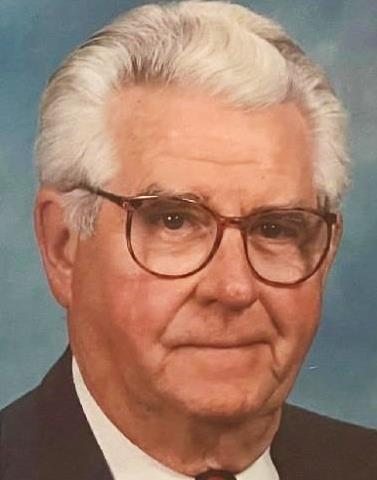
When I began covering Tompkins County Government as a radio reporter in the early-1970’s, John Murphy had already become a fixture in that governing institution. We’d hired him away from NCR. First appointed as Commissioner of Budget and Administration during the months when the old Board of Supervisors was transitioning to the Board of Representatives (as our county’s governing body was then called), John was, effectively, our County’s first Chief Executive Officer. He oversaw every financial element of Tompkins County Government, which then even included a hospital. We built a new one, and then spun it off to a non-profit corporation, the current Cayuga Medical Center we know today. John helped us build the TC3 campus too. In 1973, Murphy’s position was elevated to that of County Administrator, its current title. John Murphy retired in 1985.
This legend of our current Legislature’s earlier years died Saturday, January 15th, less than three months short of his 100th birthday. John was always a gentleman, patient with reporters, no matter how probing their questions. It was a quieter time then; more collegial too. Government became family. Legislators and administrators met for euchre parties in their off hours. Government was smaller; bureaucracy simpler; departments fewer. Yet they always demanded thoughtful, professional oversight. John Murphy—along with the other memorable, soft-spoken titans of that age; faces and names I will always remember—helped establish within Tompkins County Government what I’d termed during my last year’s legislative campaign, “the unspoken spirit of the place; the gravitas inherent in this county’s governance.”
As a later County Administrator, Joe Mareane, would write in a tribute to his predecessor, words read at the County Legislature’s meeting last Tuesday night:
“With support and guidance from the Board of Representatives, John was instrumental in the creation of the modern county we know today, enabling Tompkins to deliver a growing range of largely-mandated services effectively and efficiently.”
As time marches, a few of our best soldiers always fall back. But whenever one of the legends from your earlier days passes, a little of you passes along with him. John Murphy, rest in peace. You are missed. You served us well.
Bob Lynch
###
Torn Legislature struggles to grant Sheriff late-term raise
by Robert Lynch, January 18, 2022

“It’s seriously out of whack from where it should be,” said newly-seated County Legislator Lee Shurtleff Tuesday night (Jan. 18th) as just about everyone in the meeting chimed in with his or her opinion on whether Tompkins County Sheriff Derek Osborne should receive a pay raise above that from the pay grade he accepted when he ran for office four years ago and get a jump start on the raise he’d earn if he wins re-election later this year.
He’ll get that late-term raise—but just by the skin of his teeth. After 45 minutes of free-wheeling debate, the Tompkins County Legislature nearly tore down the middle and granted the step-up in Sheriff’s pay, eight votes to six. Had the raise found one fewer supporter, it would have lost.
“We’re in exceptional circumstances here,” said Budget Committee Chair Deborah Dawson, lead supporter for the previously-unplanned Sheriff’s raise. “Circumstances changed the nature of the game midstream.”
The key change, as just about everyone admitted, was a recent move by County Human Resources Commissioner Ruby Pulliam—she admitted it was her decision—to reclassify the job of Osborne’s Undersheriff, Jennifer Olin, so that Olin now makes more than Osborne does. Osborne earns just over $101,000; Olin now about $111,000. In late-December, the Legislature cured the inequity for the next term—upping 2023 Sheriff’s pay to just over $136,000, effective next January. But what lay before lawmakers Tuesday was raising pay similarly (to about $132,000) for the final year of Osborne’s current term. And debate centered less on wage justice and more on principle.
Dryden’s Mike Lane led the charge against the late-term raise, challenging Dawson’s comparison of the Sheriff’s Department to a “military organization” where the Colonel shouldn’t earn more than the General.
“How many Generals or Admirals are elected by the public?” asked Lane. “None.”
Lane argued enacting a late-term raise sets a “terrible precedent.”
“He (Osborne) went into this with the understanding of what the salary would be,” said Lane. “I’m sorry it (the raise) was brought forward. An elected official is a lot different than an appointed Police Chief.”
“It is changing a long-standing precedent,” acknowledged Groton’s Shurtleff. But then, again, he said, “The salary may have been set from time to time in an arbitrary manner.”

Expecting possible citizen pushback to the increase, the County Legislature put the issue to a Public Hearing at the start of its meeting. No one spoke. And conspicuous by his absence—though he’d purportedly lobbied for the raise—the Sheriff attended neither the Hearing nor the Legislature’s subsequent discussion, nor did any of Osborne’s staff.
“I’m looking at this from the basic point of fairness,” said Lansing’s Mike Sigler, glad that Lane had raised the issue, but choosing to fall on the other side.
“We’re not operating in a vacuum,” said Sigler. “You can’t have people working for you making a lot more than you.”
Arguments continued. “I have no quibble with our Sheriff,” said Public Safety Committee Chair Rich John,” whose committee oversees Osborne’s Department. “But we’re changing in mid-stream.”
“I’m struggling with it a little bit,” said newly-installed Newfield-Enfield Republican rep. Randy Brown. “To me, it’s money.” Brown said he has to look at a Sheriff’s pay through the same lens as he does spending funds on youth programs in Enfield.
In casting the Legislature’s razor-thin vote, both Brown and John opposed the Sheriff’s raise. The second legislator representing Enfield, Anne Koreman, supported it.
“I don’t think it matters if elected or appointed,” the Legislature’s new Chair, Shawna Black, maintained, weighing in near the end of the three-quarter hour debate. It’s “straight chain-of-command,” she said. The Sheriff, Black pointed out, has a “ton of responsibility.” He doesn’t qualify for overtime. “This is checks and balances here,” she said. “This is our chance to get it right.”
In retrospect, the late-term raise might never have been broached had HR Commissioner Pulliam not recently upgraded Olin, a move that sparked caustic comment on the zoom room comment portal and led legislators to order the County’s Communications Director to shut the chat room down.
“To change (the salary) now makes a change that was not anticipated,” argued Lane in his losing effort to derail the increase, one that almost succeeded. “This was not in front of the candidates who ran for Sheriff three years ago.”
Three candidates ran for Sheriff back in 2018. Only Osborne has so far declared for Sheriff this election cycle. And there’s yet another election that could be looming. The law permits opponents of the increase to petition for a referendum to roll it back—but only for this year. They have 45 days to circulate petitions. Lane insisted you can’t gauge grass roots sentiment by Tuesday night’s no-show online hearing.
Also Tuesday, in a meeting shorter than most, the County Legislature approved moving $63,500 from its Contingent Fund to beef up staffing assistance at the 2-1-1 human services hotline, funding to meet increased demand placed upon the service by COVID-19 (See earlier story, posted here, December 16th.)
“I’ve heard from the public,” said Koreman, “and it’s really valuable to have 2-1-1 services. We keep asking them to do more things.”
###
Enfield Board Adopts Water Law; guides County Redistricting

by Robert Lynch, January 14, 2022
“Do we need this law?”
Planning Board member Ann Chaffee most famously asked that question last August addressing a proposed Water Protection Law for the Town of Enfield. Wednesday night (Jan. 12th) an overwhelming majority of Town Board members agreed that we do need it. Likewise, so did those who spoke at a Public Hearing an hour before the Town Board’s unanimous vote to adopt the six pages of rules, those that would subject new, non-agricultural, large-volume water users to extra scrutiny so as to protect the quantity and quality of well water for everyone else.
Wednesday’s action came at the Town Board’s first meeting of the New Year, one at which members also adopted a Resolution seeking to guide Tompkins County in local legislative redistricting, a measure urging an independent commission not to chop Enfield into too many pieces. The Board also passed annual organizational measures, none of which will alter the course of Enfield government significantly.
“It’s simple and it sets standards,” Nancy Spero, Chair of the Town’s Water Protection Committee, said of the Water Law at the Public Hearing preceding the Board’s vote. “Some I have heard occasionally say they think it’s unnecessary,” Spero acknowledged. “But to me that means it’s proactive and not reactive.” Translate that comment to mean that should a high-volume user suddenly enter the town, Enfield would have regulatory tools in place.
Councilperson Robert Lynch (this writer) became the meeting’s chief skeptic. Sharing planner Chaffee’s earlier doubts, Lynch questioned the concerns of some—most notably Town Supervisor Stephanie Redmond—that Nestle or some other corporate bottler might somehow be lurking, poised to drain Enfield dry. He also worried that added regulation might drive away future businesses the town could use, like a laundromat or a car wash.
Nonetheless, deferring to Public Hearing sentiment, and sensing a lack of resistance, Lynch joined the Board’s majority in supporting the law. Yet the Councilperson failed in his effort to temper the law with an amendment that would have quadrupled the proposed water consumption threshold triggering Planning Board scrutiny. His amendment, losing four-to-one, would also have explicitly exempted farming operations from the consumption threshold, something planners and water experts assured him existing law does anyway.
The new, sparingly-worded Water Law imposes few, if any, new restrictions of its own. Rather, it demands large-volume water users and waste producers first seek enhanced review under Enfield’s site plan law. Water consultant Steven Winkley, who aided the Water Committee in drafting Enfield’s new regulations, said the 1000 gallon-per-day consumption trigger was set to exempt the average single-family residence from the law’s key provisions.
To date, the Enfield Water Law has drawn little public concern and no expressed opposition. The handful of speakers at Wednesday’s Hearing—all of them supportive—disproportionately came from the ranks of the Water Committee. They were joined by Mimi Mehaffey, a former Town Board member.
This law is a “really important beginning,” Mehaffey remarked, suggesting—perhaps unknown to others both in and out of Enfield government—that “there’s more to come.” Mehaffey did not elaborate.
Spero insisted the law strikes a “perfect balance” between businesses and the public. “It’s not an onerous law,” she insisted. “It protects farmers and businesses. … It just means they’ll have to present information to the Planning Board if they reach certain thresholds.”
But in pressing his skepticism, Lynch sought assurance that the law will never reach the cow stable door.
“I want to assure the farmers in this town,” said Lynch, “that they don’t have to worry—well, I want to buy 10 more cows; do I have to go to the Planning Board and get site plan review to have those 10 more cows? Because they’re going to drink a lot of water.”
Consultant Winkley responded that with “95 per cent of Enfield in an agricultural district,” New York’s Right-to-Farm Law exempts farms from site plan review.
“But State law can change on a dime,” Lynch cautioned. He zeroed-in on the long, narrow, former Genex bull barns at Hayts Road and Sheffield, on land recently sold to a farmer. “That can hold a lot of cows,” Lynch observed.
Planning Board Chair Dan Walker rebutted that as long as those barns remain in agriculture, they stay exempt. And even if the law changed, Walker said, only a building over 5,000 square feet would trigger commercial status review. The water law, he insisted, would not now reach it.
However, any new, modest-level commercial water consumer, like a laundry or car wash, could feel the law’s impact. Yet Water Law supporters insisted it wouldn’t be enough of an impediment to drive them away.
“We try to establish a community of Enfield, where we have basic services provided,” Lynch told the Board. “And there might be somebody who wanted to establish a small, modest laundromat at Miller’s Corners. Same with a car wash. And I’m just thinking, you know, this (the Water Law) might be a deal-breaker for them. They’d say I’m not going through this. I’m going to go someplace where they have sewers and I don’t have to worry about the effluent.”
“This isn’t preventing them from coming to Enfield,” Winkley responded.
“But it might dissuade them economically,” Lynch rebutted.
Arguments over—and with Lynch’s amendment rejected—all Town Board members voted to adopt the Water Protection Law, which takes effect as soon as filed with the Secretary of State.
****
Faring better for Councilperson Lynch, and adopted unanimously without significant debate, was a Resolution he’d drafted urging a County-established Independent Redistricting Commission not to slice and dice Enfield into too many County legislative districts—and maybe even to combine all residents into a single district—when it re-aligns those districts to reflect recent population changes.

“Hear, hear,” responded Supervisor Stephanie Redmond. “I agree wholeheartedly.”
For decades, Enfield has found its representation split between two districts on the 14-member County Legislature, the current dividing line being the Route 79 centerline. Anne Koreman (District 5) represents northern residents. Randy Brown (and until recently, Dave McKenna; District 8) represents those to the south. Neither lawmaker hails from Enfield.
“To a certain extent, we feel like a child whose parents have joint custody,” observed Lynch, relating to the Board an analogy he’d made at a Commission input session the night before. “Sometimes we’re with one, sometimes with the other. We do the best we can. But we don’t need a third parent.”
While stressing both Koreman, Brown and their predecessors have served Enfield well, Lynch affirmed an observation made in years past by former Enfield Supervisor Beth McGee and argued that being served by fewer legislators increases the Town’s clout in county governance. To carve the Town into three districts—or perhaps, even four— “diminishes our influence in County Government,” Lynch argued.
“I don’t want to see us fractured any further,” the Councilperson told his colleagues.
The Tompkins County Independent Redistricting Commission (one of whose members is Lynch’s sister, Marcia) will submit a redistricting plan to the Legislature for consideration later this year. Nonetheless, that plan’s implementation remains unlikely until current legislative terms expire at mid-decade.
****
The Enfield Town Board consumed the final third of its first-of-the-year meeting conducting first-of-the-year business, approving with only occasional debate, as many as two dozen organizational matters ranging from setting meeting dates to designating its official newspaper for legal ads. Among the highlights:
- For the second straight year—and again, avoiding controversy—Board members rejected for lack of a seconding vote Councilperson Lynch’s motion to restore the Pledge of Allegiance to a permanent place at the start of every meeting. Board members in 2020 reassigned the Pledge to a floor privilege, making it optional to those who’d request it. The change sparked months of heated debate. Wednesday’s refusal to reverse the 2020 decision occurred quietly. After brief silence, the Board plodded on.
- The Board’s majority likewise rejected a second change Lynch had suggested, one that would have begun monthly meetings at 7 PM, instead of their customary 6:30. Lynch raised the change, he said, “for argument’s sake alone,” relaying a constituent’s complaint that 6:30 meetings begin too early, with some families still eating supper. The time change received no seconding vote. Supervisor Redmond took the position that meetings run too late already. A later start-time, she said, would make matters worse.
- But with late-night fatigue firmly in mind, Lynch found better luck with another proposal. The Board endorsed a guideline to attempt ending meetings by 10 PM and to require a majority Board vote to keep them going longer.
- The Board resolved, through compromise, a testy topic that it couldn’t even settle last year. It decided who should manage of the Town’s emails and website. In March 2020, without issue, the Board placed those cyber-management duties with the Town Clerk. Then last January, when the Supervisor sought to transfer them to the Town Board, former Clerk Ellen Woods strongly objected, Woods fearing the transfer would turn the website into the Supervisor’s political tool. With Woods no longer Clerk, but with Lynch continuing her argument, the Board found middle ground. It agreed to place management with the Town Board—as Redmond asserted the law requires—but then to delegate daily management to the Town Clerk. It passed unanimously.
- But perhaps the evening’s sharpest exchanges occurred when Supervisor Redmond asked the Board to create a new position of maintenance for buildings and grounds. Redmond had sought to fill the $18 per hour, part-time job last year, but found no takers. The Board then zeroed-out the position at budget time. Lynch refused Wednesday to authorize a job not budgeted. Redmond then pressed him to answer how the park-and-ride lot would get mowed and clogged drains cleaned. She asserted contracting out the work would cost more. Lynch disagreed.

“If you create a new position,” Lynch argued, “that position will grow by sheer inertia. That person will find things to do and ask for things to do, and pretty soon you’ll be paying more than you pay contractually.”
Redmond pushed back. But rather than bring the issue to a vote, the Supervisor begged from Lynch a solution. “We need to think about how we’re going to mow across from the Town Hall,” she quizzed the Councilperson. “Are you going to volunteer to do that? You can.”
“If necessary, yes,” Lynch replied sharply.
Expect to see Bob Lynch this summer riding the Town mower. No decision yet on who’ll snake the clogged sink.
###
No Drama, just praise as County Legislators pick Shawna Black Chair
by Robert Lynch, January 5, 2022
The last time the Tompkins County Legislature chose a new Chair, it took eight ballots spread over four meetings and seven weeks before members could end an impasse and select Leslyn McBean-Clairborne two years ago to become their first African-American leader.

Tuesday night (Jan. 4th) the Legislature set another milestone, but one accomplished with far less agony.
By quick, unanimous votes, lawmakers chose Shawna Black to become their first openly gay Chairperson. No one nominated a competing candidate. Republican Mike Sigler seconded Democrat Black’s nomination. Only praise was showered upon the Legislature’s new Chair. With five new members—including Newfield-Enfield’s Randy Brown—joining the 14-person body this month, all appearances are that County lawmakers have begun 2022 as a team.
With like unanimity, lawmakers then elected Lansing’s Deborah Dawson, a close Shawna Black ally, as Legislature Vice-Chair. Both Black and Dawson hail from the Legislature’s “Sophomore Class,” each commencing her second, full four-year term on the lawmaking body. Legislators ballot on leadership annually. McBean-Clairborne exited the Legislature at year’s end, having chosen not to seek reelection.
Neither Black’s nor Dawson’s election came as much of a surprise. Legislative insiders had for weeks predicted the duo’s elevation. Black has served as the Legislature’s Vice Chair since 2019.

“I’m honored to be chosen by you, my colleagues, to be the Chair of this incredible Legislature,” said Black, as she took the gavel to begin the Legislature’s three-hour meeting. “The past four years have been a rollercoaster of sorts,” she observed, “with a very steep learning curve in the beginning and some very crazy times over the past two years,” that latter comment referencing the COVID-19 pandemic.
“Shawna does not see herself as a trailblazer,” remarked Enfield-Ulysses legislator Anne Koreman—like Black, openly gay—as she placed Shawna’s name in nomination. “She is, however, a trailblazer,” Koreman insisted, “for young parents, women, and the LGBTQ-plus community.” Black and her wife, Margo, are raising three young children.
“It’s always great to see someone who really grows into something,” said Republican Sigler, as he seconded Shawna’s nomination. Sigler conceded Black might not have known everything about the job of legislator at the start. “But she was able to grow so quickly,” he added, “to be able to chair a committee, and just to be a good legislator.”
Sigler credited for Black’s rapid rise how she approaches her job; “from the position of kindness,” he said. “That’s something that’s missing a lot.”
“We will continue to be challenged by the COVID-19 pandemic,” Black acknowledged as she took the lead at Tuesday’s meeting. “However, we will need to create a New Normal moving forward and work towards a life with COVID to create goals and purpose for our County Government.”
As for her priorities, Black stressed employee development, including an upcoming government-wide salary study of employee pay, and also the advancement of “equity and diversity” throughout the organization.
And then there’s the nagging issue of meeting length, with evening sessions dragging ever-longer, often approaching four hours per night, with meetings twice a month.
“While I will not put limits on the time legislators can speak,” assured Black, “I hope we can all be mindful and respectful of each other in our time and patience. I will ask my colleagues to have crisp comments so that our meetings are an efficient use of everyone’s time.”
Shawna Black promised to say more about her vision for Tompkins County’s future at the Legislature’s next meeting, January 18th.
###
Competing Dem, GOP House maps each point Tompkins County north
by Robert Lynch, January 3, 2022; Updated January 4, 2022 @ 10:00 AM
Update: Assemblymember Anna Kelles early Tuesday criticized the Redistricting Commission’s Democratic-sponsored plan that would remove Cortland County from her 125th Assembly District; see below.
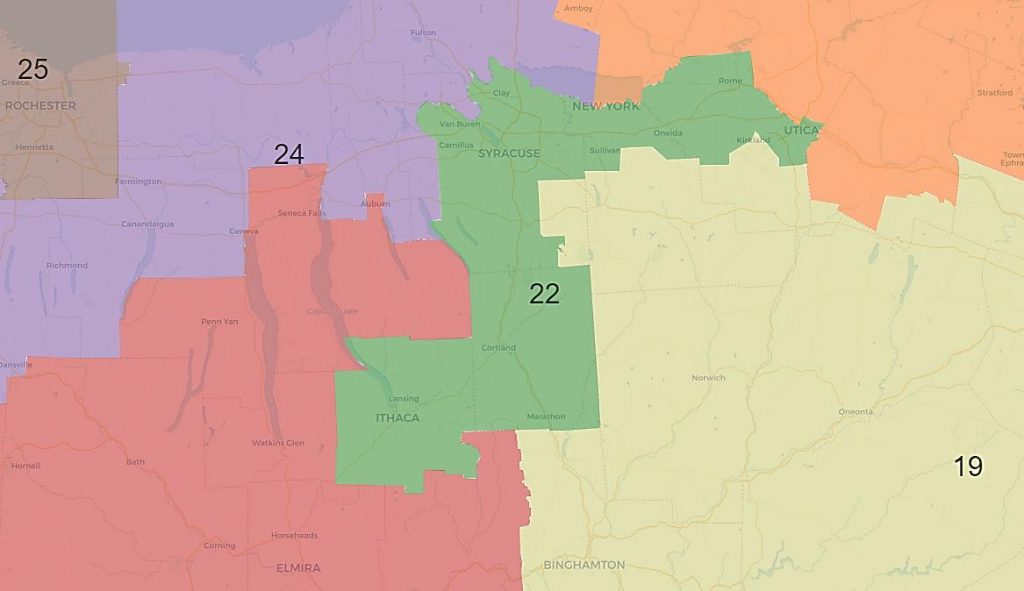
For 32 minutes Monday (Jan. 3rd), ten members of New York’s Independent Redistricting Commission wrangled and threw political barbs at one another, Then they split evenly on which of two alternate reapportionment maps, pairs each for Congress, State Senate and Assembly, to send to the State Legislature for a vote.
Yet for Tompkins County, the Commission’s deadlock may matter only at the margins. In each instance, the rival Republican and Democratic proposals would pull Tompkins County’s Congressional representation away from the sprawling Southern Tier district, now represented by retiring Republican Tom Reed, and instead aim it toward the Syracuse region now served by another Republican, John Katko.
In fact, one party’s districting map would place Tompkins’ Republicans as enviable deciders in a probable primary slugfest between the more moderate Congressman Katko and freshman Rep. and Trump-conservative Claudia Tenney. The other party’s map, according to media reports, would leave Katko alone for the GOP and instead pit Tenney against a Democratic incumbent from the Hudson Valley.
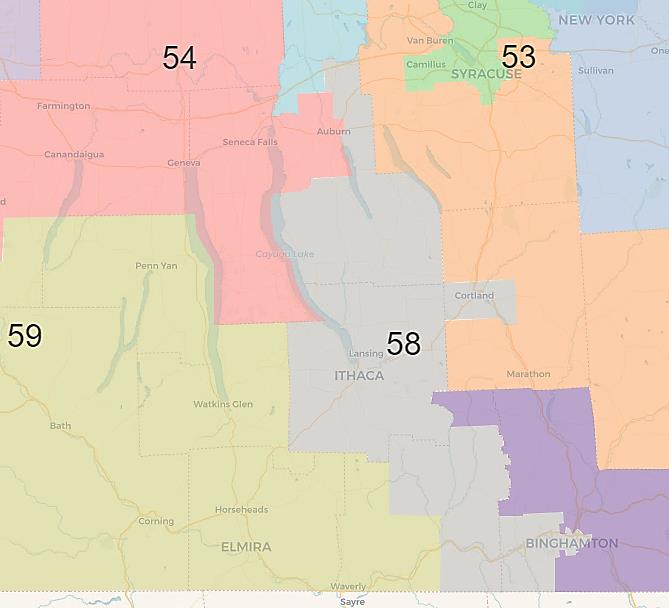
Meanwhile, for the State Senate, both Republican and Democratic-backed maps propose radical change for Tompkins’ voters. No longer would Enfield, Newfield, Ithaca, and the county’s other western reaches be tied with the Elmira-Corning district of Republican Tom O’Mara. Instead, they’d be drawn into a new Tompkins-centered district reaching southeast toward Binghamton, a district likely to be far more friendly to Democratic Party prospects.
As for the State Assembly maps, gone is the prospect, raised in a prior Republican draft, of splitting Tompkins County down the middle and severing Enfield, Newfield, and Ulysses from Democrat Anna Kelles’ representation. Both maps released Monday would keep all of Tompkins County within Kelles’ 125th District. However, while the Republican map would keep the Kelles’ district much as it is— retaining the City of Cortland within it—the Democrat’s alternative would cut off Cortland and instead snake the 125th north to Skaneateles and the western exurbs of Syracuse.
Early Tuesday (Jan. 4th), in response to this reporter’s inquiry, Assemblymember Kelles criticized the Redistricting Commission’s Democratic-sponsored option that would remove Cortland County from her 125th District.

“One of the primary points of consideration for a district is what constitutes communities of interest,” said Kelles. “Not only have Tompkins and Cortland County been in the same district for decades but they both have SUNY campuses so they are both important academic centers in this area. Additionally, we share a community college between the two counties. Both counties also share a significant overlap in workforce. For example, Tompkins County has approximately 15,000 in-commuters every single day and a majority of them come from Cortland County.”
“For all of these reasons I do not support a map that would separate Tompkins and Cortland completely into separate districts,” Kelles concluded.
Of interest to note, none of the alternative designs by either party for any of the three state or federal offices would tie Tompkins County with any part of Chemung, Schuyler, or Seneca Counties.
Though Tompkins County would no longer maintain its atypical “crazy uncle” outlier status—as a quirky, liberal appendage campaigning Republican Reed oftentimes mocked—the Southern Tier district, a longtime fixture in New York Congressional politics, would remain relatively intact under either party’s plan. Republicans would stretch the redesigned New York 23rd east into the Binghamton metro. Democrats would place Binghamton—currently represented by Tenney—with Hudson Valley Democrat Antonio Delgado’s district, and backfill Reed’s 23rd by peeling off Buffalo’s southern suburbs.
At regional public hearings in September, Southern Tier leaders loudly lobbed for the Reed District’s retention. They maintained the string of counties along the state’s western Pennsylvania border formed a common “community of interest” reapportionment line-drawers are duty-bound to respect.
What’s lost in either of the Commission’s proposals, under its mandate to shrink New York’s Congressional districts by one, is any semblance of a Tenney District, the one previously served by Anthony Brindisi, and several terms earlier by Sherwood Boehlert. The Commission’s carving thus leaves Republican Tenney to blow somewhat in the political wind. The Republican map would reportedly pit her in a general election contest with Delgado. The Democrat’s alternative would set up a Tenney-Katko primary fight in June. The Democrats’ plan would snake the rebuilt 22nd District from Newfield to Utica, sucking in Katko along the way and also including Tenney’s hometown of New Hartford, a Utica suburb. The Republican design would do much the same, only put New Hartford in Delgado’s district.
An angry Tenney, in a statement reported Monday by the Syracuse Post-Standard, said the Independent Redistricting Commission “defied the will of the people and failed their constitutional duty to draft a single, bipartisan district map for Congress, state Senate and state Assembly.”
Rather than a capstone moment in a stunning once-in-a-decade deep-dive into democracy, Monday’s Redistricting Commission meeting carried all the underwhelming politics-as-usual tarnish that critics of the calling most choose to deride. Fingers were pointed often. Praise flowed but sparingly.
“Throughout this process, what has disappointed me most about my Republican colleagues,” chided Democratic Commission Chair David Imamura, “is their seeming indifference to public input and an unwillingness to put pen to paper and modify their map.”
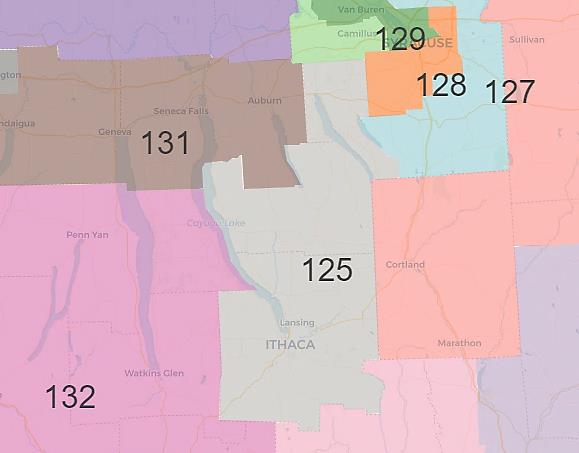
“I joined this bipartisan commission to draw fair maps that best represent the vast diversity of the people of New York State,” Imamura continued. “I did not join this commission to allow my Republican colleagues to hold hostage the hopes of New York’s most disadvantaged voters in an effort to regain GOP majorities. I joined this commission to design fair maps that reflect the public interest. And it is the Democratic maps that achieve that goal, not the Republicans.’”
Republican Vice-Chair Jack Martins took exception to Imamura’s assessment. And in a 12-minute monologue, he slammed the Democrats for abandoning consensus, for purportedly walking away from negotiations in late-December, for drafting their own maps, and for ignoring the GOP.
“The fact that the Commission members appointed by the (Democratic) majority in the Legislature chose to go out and draw their own map was up to them,” said Martins. “But our effort was to reach consensus without either side digging in their heels and advancing partisan maps.”
“We let the State down. We let all the people who participated in the process down by not having reached that consensus,” Martins concluded.
The two sets of maps—“Plan A” from the Commission’s five Democrats; “Plan B” from its equally-numbered Republicans—now head to the State Legislature. Albany lawmakers can accept one set, accept the other, toss both sets back to the Commission for a rewrite, or simply draft new maps of their own. Ultimately, Governor Hochul has final say.
****
Aside from a switch in Congressional representation—and the outside chance that Tompkins County could propel a Democrat to unseat the decidedly popular Katko, or more likely, the Trump-friendly Tenney—either faction’s redistricting scheme could lead Tompkins’ decidedly Democratic partisan electorate to carve out a new seat to grow the State Senate’s Democratic majority. Either party’s plan would link Tompkins to Broome County along with their Democratic-favoring urban-suburban neighborhoods.
The Democrats’ plan, as one might suspect, includes more of urbanized Binghamton and its suburbs to tag onto Tompkins County’s blue base. The GOP alternative would include less of Broome County, but extend the 58th Senate District to include much of southern Cayuga County and then stretch north between Owasco and Skaneateles Lakes to the New York Thruway. The Republican map includes Cortland. The Democratic alternative does not.
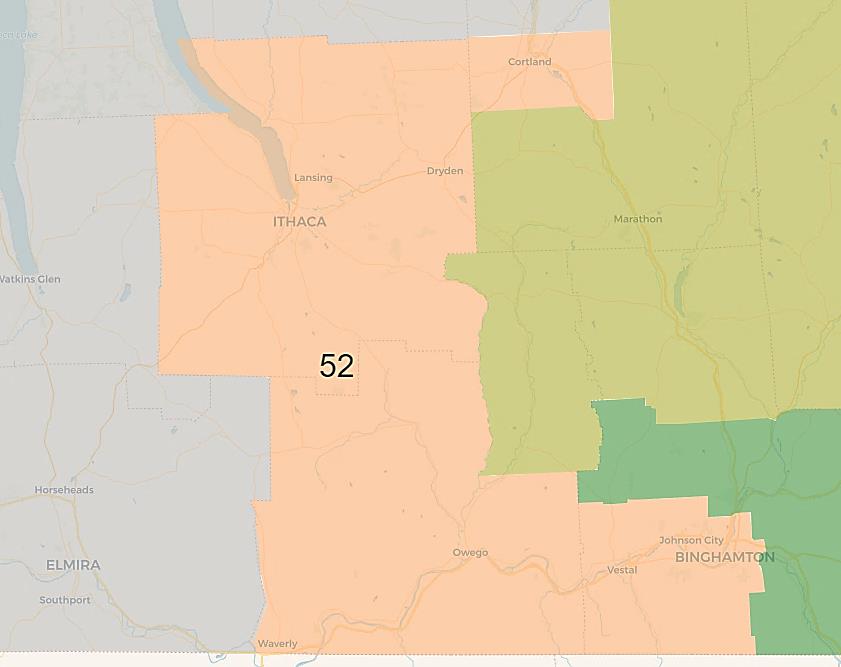
Also a major difference, the Democrat’s plan for District 58 would encompass more of Tioga County than would the Republican alternative.
Currently, the Elmira area’s Tom O’Mara represents Ithaca and Tompkins County’s western towns, including Enfield. Fellow Republican Peter Oberacker does the same for four eastern and southern towns, including Dryden and Danby. Republican Pam Helming represents Lansing in the State Senate.
Either party’s redistricting plan would consolidate Tompkins County within a single Senate District, a long-sought goal of many political activists. Two Democrats have already declared for the seat, whatever its boundaries might be. Leslie Danks Burke, defeated by Republican O’Mara two years ago, has already announced for another crack at the office, as has Binghamton Democrat Lea Webb, likely the more liberal of the two.
Both Danks Burke and Webb declared presuming O’Mara might remain their likely opponent. The current redistricting plans could alter the equation.
###

